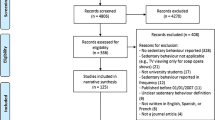Abstract
Over the last few decades, research in public health has associated inactivity with a number of ailments and chronic diseases, such as colon cancer, type II diabetes, osteoporosis and coronary heart disease. In the belief that the office building substantially shapes occupant daily activity, this work draws upon qualitative and quantitative monitoring of human activity within office buildings during typical working weeks. This research is based on data collection results regarding the design of space in relation to energy expenditure and it presents a quantitative model (named KINESIS after the Greek word for activity) that, in the form of a set equation, can simulate and estimate the total energy expenditure per person per day in a given office layout.
Similar content being viewed by others
References
Allen, T.J.: Managing the Flow of Technology. MIT Press, Cambridge (1977)
Al-Sharif, L.R.: Elevator world: lift power consumption (1996). http://www.elevatorworld.com/magazine/archive01/9605-001.htm, Date accessed 09/07/08
Rassia, S.Th., Hay, S., Beresford, A., Baker, N.V.: Movement dynamics of office environments. In: 3rd CIB International Conference on Smart and Sustainable Building Environments, Delft, Netherlands, 2009. Proceedings of SASBE 2009 [Online]. Available: http://www.cl.cam.ac.uk/_sjeh3/movement
Stampfer, M.J., Hu, F.B., Manson, J.E., Rimm, E.B., Willett, W.C.: Primary prevention of coronary heart disease in women through diet and lifestyle. N. Engl. J. Med. 343(1), 16–22 (2000)
Tyni, T., Ylinen, J.: Elevator system. World Intellectual Property Organization (2006). http://www.wipo.int/pctdb/en/wo.jsp?wo=2006120283, Date accessed 05/03/09
Wannamethee, S.G., Shaper, A.G., Walker, M.: Physical activity and mortality in older men with diagnosed coronary heart disease. Circulation 102(12), 1358–1363 (2000)
Whipp, B., Wasserman, K.: Efficiency of muscular work. J. Appl. Physiol. 26(5) (1969)
Author information
Authors and Affiliations
Corresponding author
Rights and permissions
About this article
Cite this article
Rassia, S.T., Alexiou, A. & Baker, N.V. Impacts of office design characteristics on human energy expenditure: developing a “KINESIS” model. Energy Syst 2, 33–44 (2011). https://doi.org/10.1007/s12667-010-0021-6
Received:
Accepted:
Published:
Issue Date:
DOI: https://doi.org/10.1007/s12667-010-0021-6




